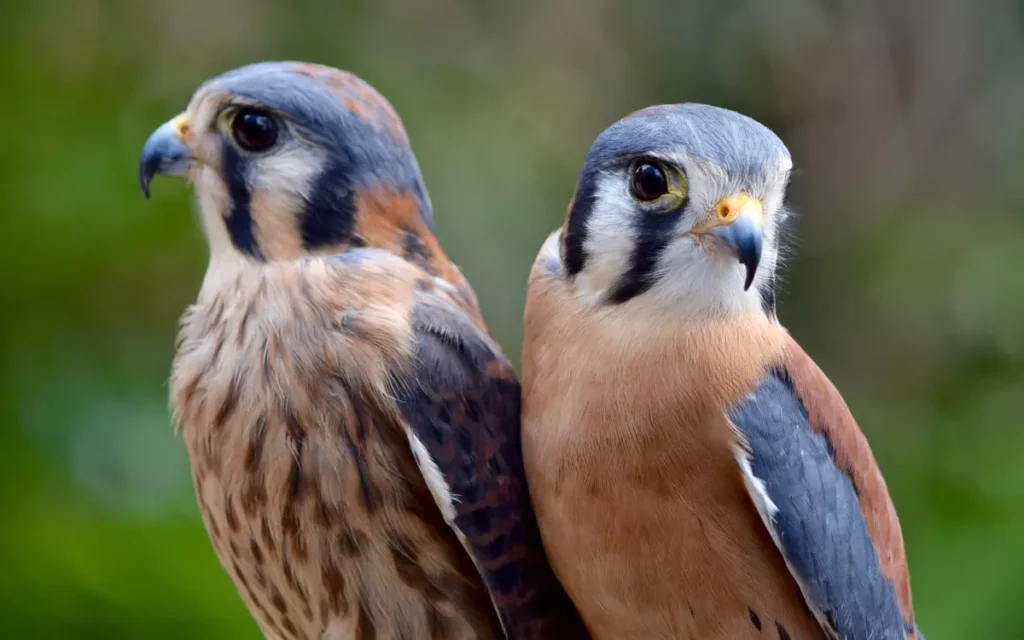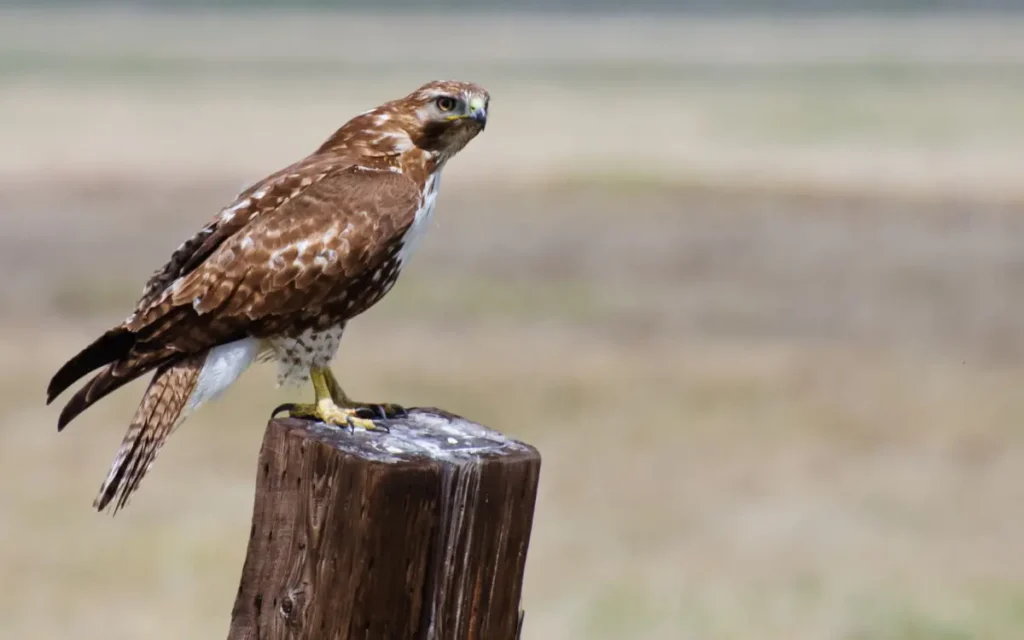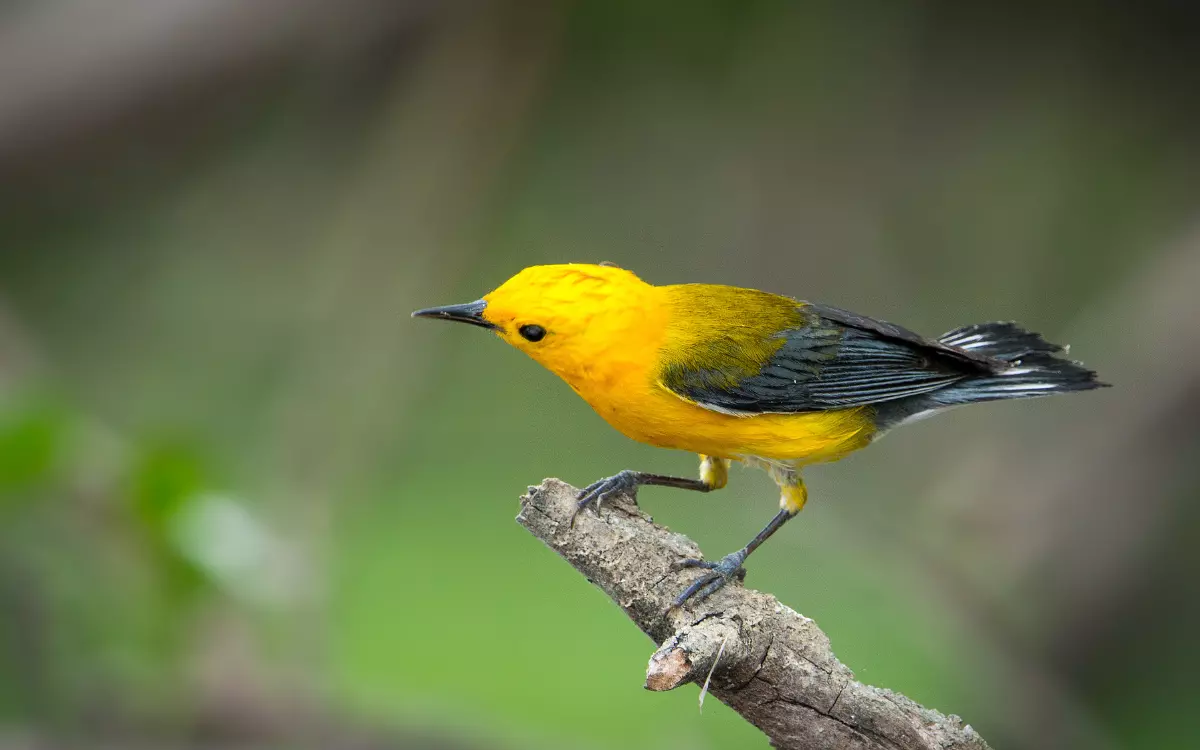6 species of Arizona falcons you must want to know
Arizona is a wonderful place with a wide variety of birds. Primarily Arizona’s falcon consists of 6 species such as peregrine, merlin, American kestrel, crested caracara and aplomado falcon.
Falcons of Arizona:
1. American Kestrel (Falco sparverius) :

The American Kestrel, holds the title of the smallest falcon in North America. This bird is easy to recognize thanks to its striking colors.
It’s quite common in Arizona, especially during summer. These falcons are amazing hunters, despite their small size, catching insects and small animals for food.
They prefer open areas and are often spotted on telephone wires. American Kestrels are important for controlling pests, helping both people and the environment.
- Length: 8.7 – 12.2 inches (22 – 31 cm)
- Weight: 2.8 – 5.0 oz (80 – 143 gm)
- Wingspan: 20.1 – 24.0 inches (51 – 61 cm)
- Lifespan: up to 14 – 17 years
2. Merlin (Falco columbarius):

The Merlin, or Falco columbarius, is known for its speedy flight and exceptional hunting skills. Unlike many birds, Merlins have a special talent for catching their meals mid-air, thanks to their agility.
They are travelers, breeding in the northern areas but spending their winters in Arizona. This makes them a seasonal highlight for local bird watchers. Merlins are not just any bird; their presence adds excitement to Arizona’s winter skies.
- Length: 10 – 14 inches (25 – 36 cm)
- Weight: 5.6 – 8.5 oz (160 – 240 gm)
- Wingspan: 23 inches (58 cm)
- Lifespan: live up to 13 years
3. Peregrine Falcon (Falco peregrinus) :

The Peregrine Falcon, is famous for its astonishing speed, reaching over 200 miles per hour during a dive. This makes it the fastest bird in the world! Peregrines can live almost anywhere, from tall city buildings to remote mountains, showing their amazing ability to adapt.
They’ve made a huge comeback from being endangered, thanks to many people working hard to protect them. Now, these incredible birds are a common sight in both cities and the wild.
- Length:14.2 – 19.3 inches (36 – 49 cm)
- Weight: 18.7 – 56.4 oz (530 – 1600 gm)
- Wingspan: 39.4 – 43.3 inches (100 – 110 cm)
- Lifespan: up to 19 years
4. Prairie Falcon (Falco mexicanus):

The Prairie Falcon, or Falco mexicanus, is perfectly suited to Arizona’s dry landscapes. These birds are masters at living in hot, open spaces where they can spot their prey from the sky.
They build their nests on cliffs or in canyon walls, laying eggs in simple scrapes. Their diet includes small mammals and birds, which they catch with amazing speed and precision.
- Length: 14 – 19 inches (36 – 48 cm)
- Weight: 17.6 – 52.8 oz (500 – 1500 gm)
- Wingspan: 3 – 4 feet (90 – 120 cm)
- Lifespan: 8-15 years
Read also:
5. Crested Caracara (Caracara cheriway):

The Crested Caracara is not your typical bird of prey. It’s a scavenger, which means it prefers to eat dead animals (carrion) but will also catch small animals if needed.
These birds are social; they like to nest and live in groups, which is pretty unusual for birds that eat meat. Their nests are built high up and are used year after year.
With a varied diet that includes everything from insects to small reptiles, these birds are amazing survivors.
- Length: 19.3 – 22.8 inches (49 – 58 cm)
- Weight: 37.0 – 45.9 oz (1050 – 1300 g)
- Wingspan: 48.0 – 49.2 inches (122 – 125 cm)
- Lifespan: around 14 to 24 years
6. Aplomado Falcon (Falco femoralis):

The Aplomado Falcon, is a rare bird, making it a special sight. Efforts to bring them back to places where they’ve disappeared have been underway, showing the care people have for these falcons.
They love open grasslands and savannas for hunting, using their speed and agility to catch prey. Watching an Aplomado Falcon chase down its dinner is a lesson in nature’s drama.
Keep these efforts in mind when thinking about how we can help protect and restore the homes of such magnificent creatures.
- Length: 14.2 – 19.3 inches (36 – 49 cm)
- Weight: 37.0 – 45.9 oz (1050 -1300 gm)
- Wingspan: 48.0 – 49.2 inches (122 – 125 cm)
- Lifespan: at least 21 years
Habitats and Behaviors:
American Kestrel:
Habitat: The American Kestrel loves open areas with fields and trees. They can even be found in cities, perching high to watch for prey.
Hunting and Diet: These small falcons catch insects, rodents, and small birds by diving down from their perches. They can hover in the air to spot prey before swooping.
Merlin:
Habitat: Merlins prefer wide-open spaces too but are more likely to be found in forests and coastal areas during migration. In winter, they enjoy Arizona’s warm climate.
Hunting and Diet: Merlins are fast flyers, chasing small birds in the air with incredible speed. They work together in pairs to catch their food.
Peregrine Falcon:
Habitat: Peregrine Falcons are adaptable, living in high-rise buildings in cities as well as cliffs and mountain ranges. They’re found statewide.
Hunting and Diet: Known as the fastest birds, they dive at over 200 miles per hour to snatch birds mid-flight. Their diet mainly includes birds.
Prairie Falcon:
Habitat: The Prairie Falcon chooses the open desert and grassland. They need wide, open spaces to hunt and nest on cliffs or in rock crevices.
Hunting and Diet: These falcons hunt small mammals and birds, using speed and agility. They fly low over the ground to surprise their prey.
Crested Caracara:
Habitat: Crested Caracaras prefer flat, open land. They’re often seen walking on the ground in desert scrub and grasslands.
Hunting and Diet: They eat carrion (dead animals) but will also catch insects, small animals, and birds. They’re known to be opportunistic feeders.
Aplomado Falcon:
Habitat: Aplomado Falcons love open grasslands and savannas. They’ve been reintroduced to some parts of their old range, including parts of Arizona.
Hunting and Diet: They chase after insects, birds, and small mammals. Their hunting technique involves both speed and precision, making them formidable hunters.
Conservation Status and Efforts:
Falcon species face challenges like habitat loss, pesticide use, and climate change. Here’s a quick look at their conservation status and what’s being done to help:
- American Kestrel: Stable, but with efforts like nest box programs to combat declining numbers.
- Merlin: Generally doing okay, but their habitats need protecting to keep them safe.
- Peregrine Falcon: A true comeback story from being endangered, thanks to banning harmful pesticides and breeding programs.
- Prairie Falcon: Stable but threatened by land development. Conservation focuses on protecting their open land habitats.
- Crested Caracara: Not endangered, but habitat loss is a concern. Efforts include habitat protection and research.
- Aplomado Falcon: Endangered in the U.S., with reintroduction and habitat restoration efforts underway to help them recover.
These efforts include legal protections, habitat restoration, and species reintroduction programs to ensure the falcons’ future.
Falconry and Cultural Significance:
In Arizona, falconry is not just about hunting with birds; it’s an old skill that shows the close friendship between people and birds like falcons.
This activity helps people learn about and take care of these amazing birds. Falconers work with their birds, including falcons and owls in Arizona, to protect them.
By doing falconry, we find out more about the birds’ lives, what they need, and the problems they face. This helps keep the birds and their homes safe. Falconry is a way for us to stay connected to nature and remember the value of every living thing around us.
Where to See Falcons in Arizona:
In Arizona, you can see falcons in many places. They like open deserts, forests, and parks. If you want to see these fast birds, try going to places like the Coconino National Forest or
Saguaro National Park. The best times to see them are spring and summer because that’s when they are most active.
Tips for Watching Falcons:
- Use binoculars to see them up close.
- Learn what they look like; each type of falcon looks different.
- Go early in the morning or late in the afternoon; that’s when falcons are hunting for food.
While looking for falcons, you might also see ducks in Arizona. They are usually near water, like lakes or rivers. Watching all these birds can be really fun and you can learn a lot about them. Remember to be quiet and not disturb the birds.
FAQs About Arizona Falcons:
1. What types of falcons can be found in Arizona?
Ans: In Arizona, you can find several types of falcons, including the Peregrine Falcon, American Kestrel, Merlin, Prairie Falcon, and the rare Aplomado Falcon.
2. Where is the best place to see falcons in Arizona?
Ans: Great spots to see falcons include the Coconino National Forest for Peregrine Falcons, the Saguaro National Park for American Kestrels, and the San Pedro Riparian National Conservation Area for Prairie and Aplomado Falcons.
3. When is the best time to observe falcons in Arizona?
Ans: Spring and summer are ideal for observing nesting falcons, while winter is a great time to see migratory species like the Merlin.
4. Are there any conservation efforts for falcons in Arizona?
Ans: Yes, there are several conservation efforts, including habitat restoration, legal protections, and species reintroduction programs for endangered falcons like the Aplomado Falcon.
5. How can I identify different falcon species?
Ans: Look for distinct features like size, color, and flight patterns. For example, the Peregrine Falcon is known for its high-speed diving, while the American Kestrel is smaller and has colorful plumage.
6. Can I see “Ducks of Arizona” while falcon watching?
Ans: Yes, while looking for falcons, you may also spot various ducks, especially in areas near water like rivers or lakes.
7. What is falconry, and is it practiced in Arizona?
Ans: Falconry is the art of training birds of prey to hunt, and it is indeed practiced in Arizona. It also plays a role in conservation and education about these birds.
Conclusion:
Arizona falcons, from the fast Peregrine to the colorful Kestrel, highlight the state’s wildlife diversity. Protecting these birds ensures Arizona’s skies remain a vibrant part of our natural heritage for years to come.






